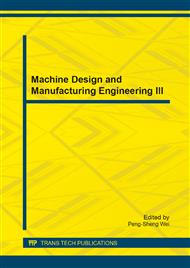[1]
Yang Wangyue, Li Zhiwen, The residual life evaluation for main steam pipe of 12Cr1MoV steel in power plant by the -projection concept, ACTA Metallurgica Sinica, Vol. 35, No. 7, July 1999, pp.721-725.
Google Scholar
[2]
He Jianbo, Bao Shiyi, Sun Weiming, Corrosion of 304 stainless steel piping and the estimate of its remain serve life, Journal of Zhejiang University of Technology, Vol. 26, No. 4, December 1998, pp.315-319.
Google Scholar
[3]
Zhao Qingna, Zhang Di, Yan Jun, Liu Ruikai, Li Erwei, Residual life prediction of long-distance pipelines, Contemporary Chemical Industry, Vol. 42, No. 5, May 2013, pp.651-652.
Google Scholar
[4]
Zhao Shi, Jiang Xiaobin et al., Reliability method for the assessment of the failure probability and remaining life of the corroded pipeline, Oil & Gas Storage, 2006, 26(12), pp.28-31.
Google Scholar
[5]
Zhi Xizhe, Zhou Hong, He Jie, Analyzing remaining life and parameter sensitivity for pipeline subjected to corrosion, Journal of Northwestern Polytechnical University, Vol. 29, No. 6, Dec. 2011, pp.984-987.
Google Scholar
[6]
Luo Jinheng, Zhao Xinwei et al, Remaining life prediction method of corroded pipeline, Pipeline Technique and Equipment, No. 5, Oct. 2006, pp.37-39.
Google Scholar
[7]
Liang Bin, Gong Jianming, Fitness-for-service assessment of the composite plate pressure vessel containing pitting defects, China Safety Science Journal, Vol. 22, No. 7, Jul. 2012, pp.36-41.
Google Scholar
[8]
Dang Xuebo, Prediction of corrosion and residual life of submarine pipeline with grey theory, Oil & Gas Storage, Vol. 30, No. 7, 2011, pp.486-489, 493.
Google Scholar
[9]
Jing Changyi, Chen Jingmei, Numerical simulation of fatigue life for pressure vessels contained surface defects, Technology & Development of Chemical Industry, Vol. 41, No. 10, Oct. 2012, pp.49-51.
Google Scholar
[10]
Li Mengsheng, Wang Lifang et al, Estimation of the remaining life of boiler superheat tubes by the hardness concept, Journal of Hefei University of Technology, Vol. 27, No. 5, May 2004, pp.518-521.
Google Scholar
[11]
Wu Mingliang, Hao Dian, Lu Jinkun, Forecast of the remaining life of corrosive oil and gas pipelines based on Grey-Markov theory, Pipeline technique and equipment, No. 5, Sep. 2008, pp.43-45.
Google Scholar
[12]
Yu Xichong, Zhao Jinzhou et al, Predicting the residual life of injecting water pipeline with the artificial neural network, Oil & Gas Storage, 2002, 21(6), pp.11-14.
Google Scholar
[13]
Paris P., Erdogan F., A critical analysis of crack growth laws, Journal of basic engineering, Transaction of the ASME, 1963(85), pp.528-534.
DOI: 10.1115/1.3656902
Google Scholar


